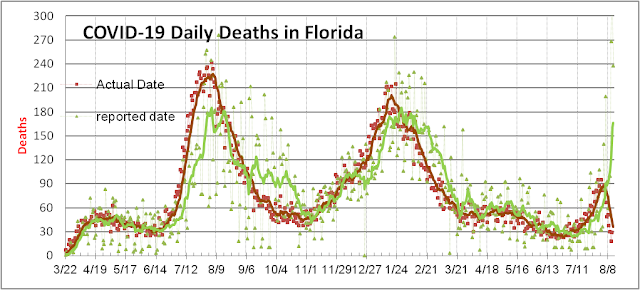COVID-19 Hotspots around the World
When people look at COVID-19 hotspots around the world, they usually look at a list of total infections and deaths by country. These are not the best statistics to figure out where the most dangerous areas for infections are located - the deadliest manifestations of the current epidemic.
| Country | Infections/MM | Infections | Deaths | Mortality | Mortality | Mortality |
| Coincident | Lagged5 | Resolved | ||||
| Italy | 167 | 10149 | 631 | 6.2% | 16.4% | 38.6% |
| S. Korea | 145 | 7513 | 58 | 0.8% | 0.9% | 19.0% |
| Iran | 98 | 8042 | 291 | 3.6% | 8.3% | 9.6% |
| Switzerland | 58 | 497 | 3 | 0.6% | 2.5% | 50.0% |
| China | 57 | 80761 | 3136 | 3.9% | 3.9% | 5.0% |
| Spain | 36 | 1690 | 35 | 2.1% | 12.4% | 20.6% |
| Singapore | 29 | 166 | 0 | 0.0% | 0.0% | 0.0% |
| France | 27 | 1784 | 33 | 1.8% | 7.8% | 71.4% |
| U.S. | 3 | 971 | 30 | 3.1% | 13.6% | 66.7% |
On a list of most infections, China clearly tops
the list with 80,761. On a list of most deaths, China again tops the list
with 3,136. But China has a huge population of citizens who can potentially
become infected. A normalized ratio of infections per million of
population is a more accurate measure of how widespread the infection is in
each country, how deeply the infection affects each person, and how well
each country's government is managing the crisis within its own borders. On such a "hotness" measure, China
has already been exceeded by Italy, South Korea, Iran, and Switzerland.
In these countries, COVID-19 is generally less under control. Travelers would do well to avoid these
hotspots. Indeed this figure could have
given the Italian government government an earlier warning as to how serious
their problem was and led them to close their borders sooner rather than
later. Since this outbreak is still in its dynamic stage, the hotness
figure by itself has a major issue: countries like South Korea that are doing a
great job testing their citizens will inevitably come up with higher figures,
while countries like the U.S. that are dragging their feet will show lower
figures. As testing ramps up, the U.S. hotness will surely rise and
begin to more accurately reflect how thoroughly they are caring for their
citizens. (A table of number of tests
done per million population could be used to correct this problem but some
countries such as the U.S. have stopped reporting this number.)
One other statistic that people are obsessed with,
and rightly so, is the mortality rate. This is the ultimate measure of
how serious a disease is. Many people
have downplayed the seriousness of COVID-19 by claiming it's just like the
seasonal flu that kills hundreds of thousands each year without causing
anywhere near the panic that COVID-19 seems to evoke. The main reasons
seasonal flu is more accepted is that there is a fairly effective vaccine each
year for the flu and the mortality rate is near 0.1%. It affects one in a
thousand, so most people are not directly affected (and some people like
President Trump don't even realize that a close relative, in this case his
grandfather, has died from the seasonal flu). COVID-19's impact could
potentially be much higher. In a
pandemic, nearly 10% of a country's population could be infected. That 167 per million in Italy could be
hundreds of times larger. Imagine if the
number of deaths increased a hundredfold.
The global mortality rate according to WHO is 3.4% with a wide range of
uncertainty. The apparent coincident
mortality rate in Italy is 6.2% - nearly twice as high (possibly due to its
relatively older population). But even this high figure may be understated
because it assumes that every diagnosed case could immediately result in
death. In reality COVID-19 can take
about 5 days to manifest itself in symptoms, and then 9 to 16 more days to
resolve itself. We suggest that a rate
calculated by looking at the current deaths divided by the number of confirmed
infections 5 days earlier would provide a more accurate estimate of the true
mortality. Both of these are imperfect
while the epidemic is ongoing and the true mortality rate can only be
calculated when the outbreak has ended and all the confirmed cases have been
resolved into deaths or recoveries. In China, the current outbreak is
near its peak and the coincident rate (3.9%) is now nearly the same as the
lagged5 rate (3.9%) and fairly close to the resolved rate (5.0%). All these rates may need to be adjusted down
because of the COVID-19 cases that were too mild to require a test. However, in some countries like South Korea,
we suspect that they are doing a much more thorough testing process than other
countries and they therefore have a very low coincident and lagged rate and we
suspect eventually a very low resolved mortality rate near 1%. This would still make COVID-19 10 times more
deadly than the seasonal flu,a serious problem worldwide, and a grave problem
for certain countries.



Comments
Post a Comment